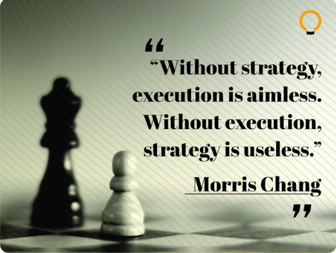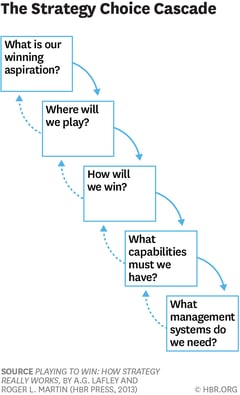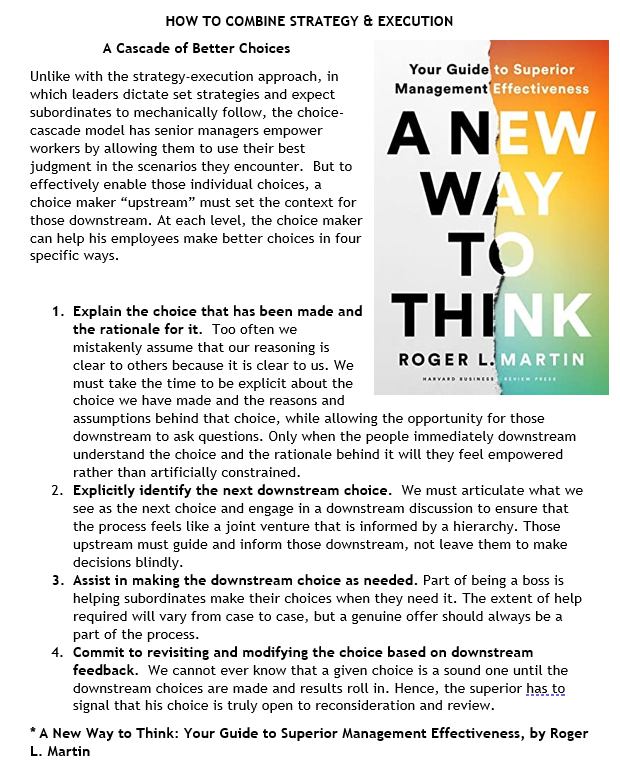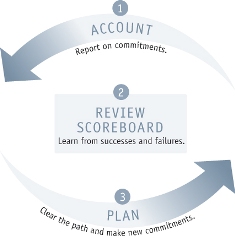 In A New Way to Think: Your Guide to Superior Management Effectiveness Roger Martin believes execution is the same as strategy.
In A New Way to Think: Your Guide to Superior Management Effectiveness Roger Martin believes execution is the same as strategy.
Two prominent CEOs on Execution and Strategy see it as two separate decisions.
“I’d rather have a first-rate execution and second-rate strategy any time than a brilliant idea and mediocre management.”
~ Jamie Dimon, now CEO of JPMorgan Chase
“Strategies most often fail because they aren’t well executed.”
~ Larry Bossidy, former AlliedSignal CEO, coauthor Execution: The Discipline of Getting Things Done
 Our Four Decisions model in Scaling up lists Execution and Strategy as two Decisions.
Our Four Decisions model in Scaling up lists Execution and Strategy as two Decisions.
Martin believes, “You cannot talk about execution separately from strategy.”
I agree. Execution and Strategy are intertwined. Martin goes further, “…the idea that we have to choose between a mediocre, well-executed strategy and a brilliant, poorly executed one is deeply flawed—a narrow, unhelpful concept replete with unintended negative consequences.”
Management theorist Kenneth Andrews established the distinction between the formulation of a strategy and its execution in his 1971 book, The Concept of Corporate Strategy, stating, “Corporate strategy has two equally important aspects, interrelated in life but separated to the extent practicable here in our study of the concept. The first of these is formulation; the second is implementation.”
When we fail to understand this interrelated dependence, the strategy fails.
Brian to Body Metaphor
Most businesspeople think of strategy as the purview of senior managers, who, often aided by outside consultants, formulate it, then hand off its execution to the rest of the organization.
To use a metaphor look at your understanding of the human body.
Martin shares: The brain (top management) thinks and chooses, and the body (the organization) does what the brain tells it to do.
Successful implementation is two distinct elements: formulation in the brain and execution through the body.
In the formulation stage, the brain decides, “I will pick up this fork now.” Then, at the implementation stage, the hand dutifully picks up the fork
The hand doesn’t choose—it does. The flow is one-way, from the formulator's brain to the implementer's hand.
That hand becomes a “choiceless doer.”
Front Line & Management at Odds
As a customer I heard this week at US Cellular, “I’m sorry, there is nothing I can do; it’s company policy.” I tried to call customer service at Squarespace this week, only to discover they don’t even have a phone number. This is the pain of dealing with a bureaucrat in a choiceless-doer framework.
The strategy-execution model fails at multiple levels of the organization, everyone from the top of the organization all the way down to the very bottom makes choices under constraints and uncertainty.
Each time a frontline employee responds to a customer request, he/she makes a choice on how to represent your business—a choice directly related to the fundamental value proposition your company is offering.
Front Line Employees: Lose-Lose
Roger Martin - Bad execution vs. awesome strategy
If employees make sound choices and produce great results, senior management gets credit for having put in place a great strategy.
On the other hand, IF there are poor results (whether due to bad choices by management, by employees, or both), the conclusion is its flawed execution.
Your employees are players in a lose-lose game: little credit if their team wins, lots of blame if their team loses.
This creates a sense of helplessness, rather than a sense of joint responsibility for success.
 To fix the problem of strategy failure, you need to stop thinking in terms of the brain-to-body metaphor.
To fix the problem of strategy failure, you need to stop thinking in terms of the brain-to-body metaphor.
Instead, you should conceive of your business as a white-water river in which choices cascade from the top to the bottom.
Each set of rapids is a point in your business where choices could be made, with each upstream choice affecting the choice immediately downstream.
Those at the top of the company make the broader, more abstract choices involving larger, long-term investments, while the employees toward the bottom make more concrete, day-to-day decisions, directly influenced by customer service and satisfaction.
Strategy is about making choices, and those choices come with angst. It involves choices at the top and on the front lines. Ultimately strategy succeeds only by implementing those choices throughout the organization through feedback and adjustment.
Watch The Importance of Choice: Michael Porter and Roger Martin
Roger Martin’s Cascade of Choices from A New Way to Think: Your Guide to Superior Management Effectiveness provides a model of how to strategize and implement better.
PLAN FOR SUCCESS
 On January 11th you can learn how to create the disciplines, differentiating strategies, greater accountability, and measurement to implement a successful strategy. These resources and tools marry strategy with execution to navigate your business to success. Attend our CEO + Leadership Bootcamp - Annual Planning Workshop to learn how to grow your company and team’s performance.
On January 11th you can learn how to create the disciplines, differentiating strategies, greater accountability, and measurement to implement a successful strategy. These resources and tools marry strategy with execution to navigate your business to success. Attend our CEO + Leadership Bootcamp - Annual Planning Workshop to learn how to grow your company and team’s performance.
To create an environment where everyone is inspired to give their best, contact Positioning Systems today to schedule a free exploratory meeting.
Growth demands Strategic Discipline.
 Four Seasons Hotels and Resorts, Chair and CEO Isadore Sharp, made the decision to build his hotel chain based on a new definition of luxury. He decided, “to redefine luxury as service, a support system to fill in for the one left at home and the office.” It required combining strategy and execution to get employees at every level to make choices to achieve this outcome. How did he do it? We’ll explore this in the next blog.
Four Seasons Hotels and Resorts, Chair and CEO Isadore Sharp, made the decision to build his hotel chain based on a new definition of luxury. He decided, “to redefine luxury as service, a support system to fill in for the one left at home and the office.” It required combining strategy and execution to get employees at every level to make choices to achieve this outcome. How did he do it? We’ll explore this in the next blog.
Building an enduring great organization requires disciplined people, disciplined thought, disciplined action, superior results, producing a distinctive impact on the world.
 Discipline sustains momentum, over a long period of time, laying the foundations for lasting endurance.
Discipline sustains momentum, over a long period of time, laying the foundations for lasting endurance.
A winning habit starts with 3 Strategic Disciplines: Priority, Metrics, and Meeting Rhythms. Forecasting, accountability, individual, and team performance improve dramatically.
Meeting Rhythms achieve a disciplined focus on performance metrics to drive growth.
Let Positioning Systems help your business achieve these outcomes on the Four most Important Decisions your business faces:
|
DECISION |
RESULT/OUTCOME |
|
PEOPLE |
|
|
STRATEGY |
TOPLINE REVENUE GROWTH |
|
EXECUTION |
|
|
CASH |
OXYGEN OR OPTIONS |
Positioning Systems helps mid-sized ($5M - $250M+) businesses Scale-UP. We align your business to focus on Your One Thing! Contact dwick@positioningsystems.com to Scale Up your business! Take our Four Decisions Needs Assessment to discover how your business measures against other Scaled Up companies. We’ll contact you.
NEXT BLOG – Four Seasons Hotels and Resorts Successful Execution & Strategy







.jpeg?width=150&height=135&name=Hand%20with%20marker%20writing%20the%20question%20Whats%20Next_%20(1).jpeg)

